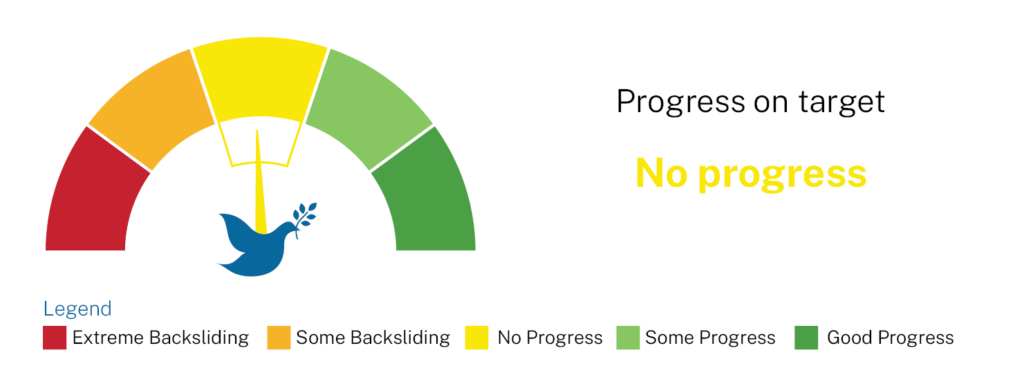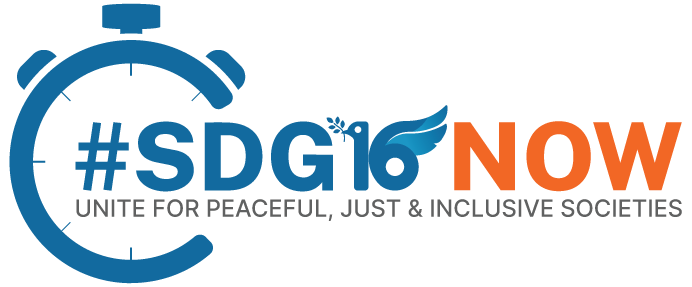Target 16.5: Substantially reduce corruption and bribery in all their forms

While nearly every country in the world has signed international agreements to fight corruption, there has been little progress in reducing corruption and bribery globally. In recent years, governments have made numerous pledges to advance anti-corruption efforts, including during the (virtual) Summit for Democracy and via the Political Declaration adopted by the UN General Assembly Special Session against Corruption in 2021. However, follow-up on implementing those commitments is lagging. There is a significant gap between countries’ legal obligations and practices. Investigations into, and prosecutions of, transnational bribery have plummeted, while the publicly-available data on enforcement actions is lacking or inadequate.
Authors of chapter


Context and Interlinkages
Corruption’s discriminatory nature means that the poor and marginalised are disproportionately affected by the way in which corruption restricts economic growth, increases inequality and skews resource distribution. When it comes to the provision of public services, bribery serves as a barrier to access public services as it increases the costs of doing so. As one of the most visible forms of corruption, bribery can also undermine trust in government. Crucially, fighting corruption can help advance the “leave no one behind” principle embedded in the heart of the 2030 agenda.
There are both direct and indirect linkages between corruption and many other areas covered by the SDGs, including access to health, education, inequality, peace and security. Corruption is interlinked with other SDG16 targets including reducing illicit financial flows which often come from corruption proceeds (16.4), access to information (16.10.2) and access to justice (16.3). Violence and corruption often go hand-in-hand, especially in cases of homicide (16.1) and attacks on journalists or land and environmental defenders (16.10.1). Furthermore, bribery and other forms of corruption often disproportionately affect women (5.1, 5.5) and marginalised groups. Also, corruption is often an enabling factor for environmental crimes and exacerbates pollution, therefore fuelling the climate crisis (SDG 13, 14 and 15).
At the international level, there are strong interlinkages between this target and international and regional conventions on anti-corruption. Countries must criminalise (or at least consider criminalising) a wide range of corruption offences under the United Nations Convention against Corruption (UNCAC), which 188 states and the European Union (EU) have joined. The UNCAC also requires states to ensure the existence of a body, or bodies, specialised in preventing corruption (Article 6) and in combating corruption through law enforcement (Article 36). Such bodies must have the necessary independence to be able to carry out their functions effectively and without any undue influence, as well as staff with the appropriate training and resources to carry out their tasks and could be considered to operate as oversight bodies, like National Human Rights Institutions (NHRIs) under 16.a.
Progress on indicators
Official Indicators:
- 16.5.1: Proportion of persons who had at least one contact with a public official and who paid a bribe to a public official, or were asked for a bribe by those public officials, during the previous 12 months (Tier I)
- 16.5.2: Proportion of businesses that had at least one contact with a public official and that paid a bribe to a public official, or were asked for a bribe by those public officials during the previous 12 months (Tier I)
Additional Indicators:
- TI Corruption Perception Index
- VDEM, Public Sector Corruption Index
- World Bank Worldwide Governance Indicators & Country Policy and Institutional Assessment
It is difficult to assess progress towards the goal of reducing bribery through official data sources given that most countries do not report official statistics on bribery regularly. The Secretary-General’s 2023 report to the United Nations General Assembly (UNGA) on progress states that around 15 per cent of businesses have faced demands to pay a bribe by public officials based on data collected in 153 countries between 2006 and 2023. The United Nations Office on Drugs and Crime (UNODC) reported in 2022 that almost one in six businesses face requests for bribe payments by public officials, with a much higher incidence in developing countries than developed ones.1
Most of the comparative data available is produced by international organisations such as the World Bank or by civil society organisations like Transparency International. Based on this data, while some countries have seen a reduction in the levels of bribery thanks, partly, to the digitalisation of public services, high levels of bribery remain a concern across most regions of the world. The results from the latest round of the Global Corruption Barometer, which provides data on experiences of corruption for more than 100 countries, also shows that bribery, favouritism and sextortion remain a concern when accessing public services or interacting with public officials worldwide. A 2021 review of the Pacific Region found that 1 in 3 had paid a bribe to receive public services,2 while for the same period in the EU, 3 in 10 did.3
When it comes to international bribery, the Transparency International Exporting Corruption report shows that after some progress between 2015 and 2018, only two countries are now actively pursuing international bribery cases.4 Out of the 47 countries included in the report, 80 per cent show limited or little to no enforcement.
The UNODC and the United Nations Statistical Commission are currently developing a framework for national statistics bodies to measure corruption through a set of direct and indirect indicators.5 Such a framework could add much value if it results in improved data collection, more readily available statistics to capture corruption-related offences beyond bribery, and also in encouraging governments to release timely and comparable enforcement data.
Additional Indicators
The official indicators take a very narrow view of corruption, focusing on bribery rather than the wide variety of offences that are prohibited under the UNCAC, which has been ratified by nearly every country in the world. A number of other sources, ranging from international CSOs, academics, and international institutions have gathered evidence on various aspects. These sources show little progress in reducing corruption worldwide.
The World Bank Country Policy and Institutional Assessment rating indicates that transparency, accountability, and corruption in the public sector rating have remained steady over the past 15 years6 while the Worldwide Governance Indicators also show little change.7 Varieties of Democracy’s (V-Dem’s) Public Sector Corruption Index – which measures how often civil servants solicit bribes and other corrupt practices – as well as their Executive Corruption Index – which measures the corrupt practices of government executives – have both recorded very slight declines since 2015. A recent academic assessment comparing laws with practices in 129 countries found a “transparency implementation gap” of 26 per cent between countries that adopted legal practices against corruption and those that actually made information available.8

When looking at the results from Transparency International’s Corruption Perceptions Index (CPI), there is also little progress. Twenty-five countries appear to have made progress in controlling corruption since 2012, but another 31 are doing worse on this front than they did a decade ago. Over two thirds of the 180 countries and territories covered in the CPI, however, remain stagnant. Particularly concerning is the recent backsliding of countries that used to top the index, including, among others, the United Kingdom and Australia.
Recommendations
- There is a clear need for governments around the world to take their commitment to produce corruption-related data more seriously. Less than 20 countries are currently producing official data on bribery through population and/or business surveys.
- States should ensure that anti-corruption and law-enforcement bodies mandated with preventing, investigating and prosecuting cases of corruption have the necessary independence as well as adequate staff, resources and powers to fulfil their mandate.
- States should ensure transparent and inclusive national UNCAC reviews that enable non-governmental stakeholders to contribute to the review process as well as to follow-up actions.
- Governments should regularly assess risks of bribery and other forms of corruption and meaningfully involve civil society organisations in the development, implementation and review of national anti-corruption strategies and action plans.
- States should adopt and strengthen legal frameworks for the protection of whistleblowers who report cases of bribery as well as other forms of corruption and wrongdoing, operate secure and anonymous reporting mechanisms, ensure adequate follow-up to reports, and provide effective assistance and protection to those who report corruption.
- States should put in place a wide range of measures to prevent bribery and other forms of corruption, including by:
- ensuring full transparency in the whole public procurement cycle and around the award of other government contracts;
- mandating the disclosure of beneficial owners of all legal entities so that bribe-givers and takers cannot hide behind anonymous shell companies;
- putting in place adequate codes of conduct for public officials;
- requiring public officials to regularly and publicly disclose their assets and interests;
- putting in place adequate policies to ensure transparency around the financing of political parties and campaigns;
- strengthening public access to information in line with international standards;
- mandating the public disclosure of lobbying activities.
Case Study: Discrimination and Corruption
Corruption and discrimination are each major obstacles to the achievement of sustainable and inclusive development. Until now they have largely been understood in isolation. The Defying Exclusion report identifies and explores the direct, causal relationship and interconnection between them. Discrimination and corruption enable and exacerbate each other in four distinct ways:
- Discrimination can result in greater exposure to corruption.
- Certain forms of corruption are inherently discriminatory.
- Discrimination can mean that corruption has a disproportionate impact on certain groups.
- Discrimination presents barriers to challenging corruption, while corruption can obstruct victims of discrimination from accessing justice.
The report presents evidence through chapters examining the links between discrimination and corruption on the basis of different grounds of discrimination: age, sex, sexual orientation, gender identity and religion or belief.
Defying Exclusion: Stories and insights on the links between discrimination and corruption https://images.transparencycdn.org/images/2021-Defying-exclusion-Report-v2-EN.pdf
Case Study: Using Access to Information to Improve Accountability
More than 40 NGOs around the world have sent access to information requests to their governments, requesting the release of documents from national UNCAC reviews so that the public can access these detailed assessments of national anti-corruption frameworks, including those designed to tackle bribery. As a result of this request campaign, coordinated by the UNCAC Coalition, close to 20 governments have released UNCAC review documents that were previously secret. The campaign complements other efforts of the UNCAC Coalition – such as the Transparency Pledge that has been signed by 34 governments – to facilitate the meaningful participation of CSOs in national UNCAC reviews and in follow-up actions to strengthen anti-corruption frameworks and their implementation.
Case Study: Parallel Civil Society Reporting
NGOs in more than 30 countries have produced parallel reports assessing the national implementation of the UNCAC in law and practice during the ongoing second review cycle, using a report template and guidance materials created by the UNCAC Coalition. These parallel reports can provide a civil society perspective to the official UNCAC implementation review process – a peer review that does not mandate the inclusion of non-governmental stakeholders. The reports also refer to illustrative cases and present available data and evidence on the enforcement of anti-corruption provisions – or lack thereof. The Coalition publishes and disseminates the reports to the Vienna UN delegations of the country under review and of the peer-reviewing countries, seeking to ensure that the report reaches the experts involved in the process.
Many NGOs engage with government anti-corruption bodies while producing the report by conducting interviews or sharing drafts for comments. This provides an entry point for future cooperation and follow-up on recommendations and identified shortcomings, thus helping to build momentum for anti-corruption reforms. In several countries, including Paraguay and Papua New Guinea, the NGO producing the parallel report was invited to present its findings to the national anti-corruption body; in numerous countries, including Honduras, Colombia, Brazil, Chile and Namibia, the NGOs were invited to participate in meetings with the country reviewers in the official UNCAC review process. In Liberia, Madagascar and Togo, NGOs have successfully advocated for reform actions identified in their parallel reports, such as the filling of vacancies of the national anti-corruption agency, the adoption of a law to protect whistleblowers, and the inclusion of identified reforms in a new national anti-corruption strategy.

